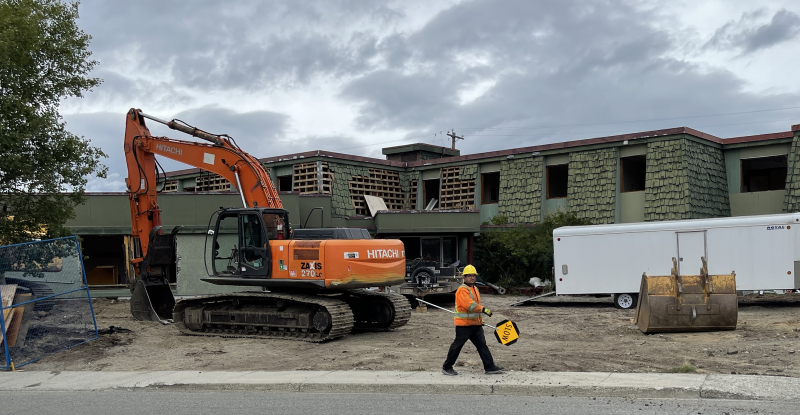Five sustainable procurement trends to drive sustainability
 Using a bid value reduction mechanism, Yukon is increasing the competitiveness of bids from First Nation businesses and providing employment in the local community. Photo courtesy of CCSP
Using a bid value reduction mechanism, Yukon is increasing the competitiveness of bids from First Nation businesses and providing employment in the local community. Photo courtesy of CCSP
With ample sustainability risks and opportunities stemming from a municipality’s supply chain, procurement is well positioned to be an engine for achieving sustainability outcomes and should not be overlooked in the broader corporate sustainability program.
More than 46 municipalities, Crown corporations, and post-secondary institutions across Canada are repurposing used products, contracting with Indigenous businesses, building net-zero facilities, and more. The Canadian Collaboration for Sustainable Procurement (CCSP) 13th Annual Report on the State of Sustainable Public Procurement in Canada highlights trends, best practices, and case studies.
Drawn from highlights in the 2022 annual report, the following are five sustainable procurement trends public sector organizations should leverage to make a positive impact.
Leverage Reuse to Advance Circularity and Save Money
Adopting circular principles into procurement criteria can help reduce an organization’s monetary spending. In addition to the environmental benefits such as reducing consumption, resource extraction, habitat destruction, and greenhouse gas (GHG) emissions, reuse can help decrease spending by extending product life and limiting resource costs.
This year, a multitude of Canadian public sector institutions actioned meaningful initiatives to enable reuse on an ongoing basis, supporting their circular economy agendas:
- The City of Ottawa teamed up with the Ottawa Community Foundation, United Way East Ontario, and the Social Planning Council of Ottawa to refurbish end-of-life laptops and improve digital access for members of the community.
- Simon Fraser University (SFU) unveiled the development of two new software platforms: SFU Marketplace and Rencyclopedia. SFU Marketplace will help facilitate the reuse of assets so university staff can avoid purchasing new items, while Rencyclopedia is a public directory to help the broader community responsibly dispose of or repair their products.
Focus on Low Carbon Construction to Reduce GHG Emissions
In Canada, the public sector is responsible for releasing eight million tonnes of GHG emissions annually associated with construction materials, according to a Clean Energy Canada Report.
The public sector is making moves to address this area of high impact. The federal government released a new Standard on Embodied Carbon in Construction, which sets minimum requirements for the procurement of design and construction services to disclose and reduce the embodied carbon footprint of major construction projects.
The District of Saanich is designing a new firehall to be made of wood (a naturally lower-carbon material) and meeting the LEED Platinum standard with a net-zero construction target.
The City of Brampton completed a procurement to retrofit a major recreation center to become the city’s first zero-carbon facility.
The City of Charlottetown’s City Works Building is under construction and has been specified to meet net-zero targets.
Operationalize Social Procurement with Supplier Directories
Social procurement, and particularly supplier diversity and JEDI (justice, equity, diversity, and inclusion) considerations, have been steadily on the rise in the last couple years – coming up to par with the longer-standing environmental pillar.
In 2022, many procurement practitioners embraced social priorities by implementing tools that connect buyers with social value suppliers. Organizations have begun connecting with third-party supplier directories, or are building their own, in an attempt to promote quick access to a list of social value vendors.
- The City of Edmonton has been working to conduct an inventory of their current supplier base to identify all local and social value suppliers within their procurement system.
- York University has set up a public-facing directory of local social value vendors.
- The University of Toronto has also implemented a diverse supplier portal as part of its efforts to support diversity in its supply chain.
Commit to Increased Spending with Indigenous Businesses
This year, we saw the Canadian public sector pushing economic reconciliation forward and supporting the economic vibrancy of Indigenous peoples and communities across the country.
A significant milestone was the federal government’s 2021 Procurement Strategy for Indigenous Business (PSIB), which sets a mandatory requirement for federal departments and agencies ensuring a minimum of five per cent of the total value of contracts issued are held by Indigenous businesses. However, other orders of government are also acting.
The City of Saskatoon increased its Indigenous spend target to five per cent (approximately $17 million in Indigenous spend annually) and embraced Indigenous art and culture through the procurement of bus shelters and bike racks that incorporated art pieces from local Indigenous artists, displaying meaningful symbols and stories from Indigenous culture and history.
The cities of Edmonton and Regina both invested time in engaging with Indigenous stakeholders to inform the development of their Indigenous Procurement Policies.
The Province of Yukon is using a bid value reduction mechanism, which increases the competitiveness of bids from Yukon First Nation (YFN) businesses. As a result, a YFN business was the successful proponent for a demolition contract in 2022, providing employment in the local community.
Adopt a Strategy and Action Plan
It is difficult to implement a high-performing sustainable procurement program without a clear roadmap. A strategy and action plan outlines the long-term vision for an organization’s program and provides a clear course of action for implementing and managing it.
In 2022, there was a surge of effort being put toward developing and approving strategies, frameworks, and action plans for sustainable procurement:
- The City of Winnipeg announced its three-year sustainable procurement action plan, outlining key activities across environmental, ethical, social, and Indigenous pillars.
- The City of Brampton passed a sustainable procurement strategy that commits to three key principles and recommended policies to develop.
- The City of Charlottetown and Town of Stratford received funding from the Canadian Federation of Municipalities to work together on their sustainable procurement strategy and action plan.
This is a clear indication that the public sector is formalizing sustainable procurement activities and moving away from the decentralized ad-hoc approach. MW
✯ Municipal World Executive and Essentials Plus Members: You might also be interested in Tammy Rimes’s article: Co-operative procurement: Creating a positive difference.
Amanda Chouinard is program manager with Canadian Collaboration for Sustainable Procurement.
Related resource materials:



